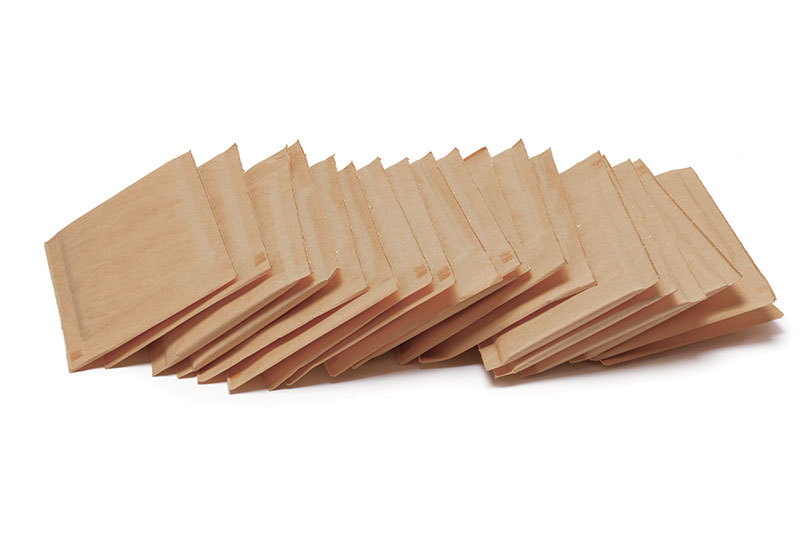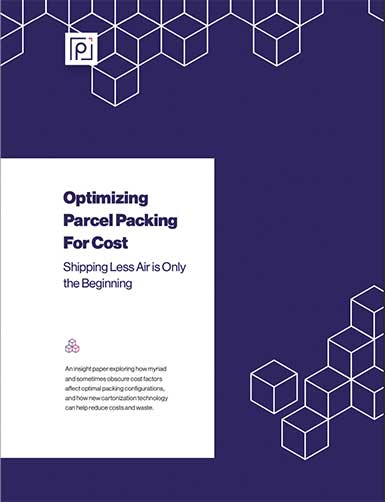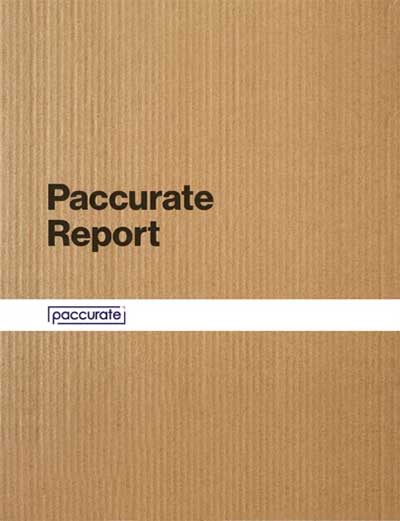Autobaggers: Out with plastic, in with paper
At least for e-commerce delivery mailers and bags, that is. Both Amazon and Walmart are making the transition as paper-based autobagger suppliers bring on new machines. It won’t all happen tomorrow, but the trend line is set.
There really is such a thing as a needle in a haystack.
For this particular story, that needle is one sentence on page 29 of Amazon’s 82-page 2022 Sustainability Report: “We are phasing out padded bags containing plastics in favor of recyclable materials.”
And while Amazon didn’t announce an end date for that transition, it’s already underway.
In 2022, “we eliminated single-use delivery plastic delivery bags for orders shipped from European fulfillment centers and replaced them with curbside-recyclable alternatives,” says the Amazon report.
Meanwhile, in the United States and Canada, Amazon last year replaced “99% of harder-to-recycle padded bags that contain both plastics and paper.” The e-commerce giant also expanded its use of paper-padded bags in the Northern Hemisphere.
By the way, Amazon is not alone here. On June 1, Walmart said it, too, will replace plastic with paper. The retailer says that move will eliminate 65 million plastic bag mailers annually. The switchover is expected to be completed in Walmart’s current fiscal year.
Looks like a trend from here: Replace plastic shipping envelopes and bags with paper as soon as possible.
Fortunately, this trend directly coincides with the very recent introduction of paper-based autobaggers from Accutech Packaging, PAC Machinery and SEE (previously known as Sealed Air). Here’s what you need to know.
The bigger picture
Needless to say (but worth saying anyway, sorry), paper e-commerce mailers are only a part of the much larger e-commerce packaging ecosystem. But exactly how big that ecosystem is in reality remains up for discussion.
For instance, research firm Fortune Business Insights pegs the global e-commerce packaging market size at roughly $45 billion in 2022 and projects growth to $66 billion by 2029.
Meanwhile, research firm Mordor Intelligence says global e-commerce packaging is already at $60 billion and will hit $115 billion by 2028. Compared to Fortune Business Insights, Mordor calls for twice the compound annual growth rate (almost 14%).
There are two general categories of packaging here—rigid and flexible. The former is dominated by cartons. Research firm Smithers says corrugated boxes will continue to account for 80% or more of worldwide e-commerce shipments through 2027.
When it comes to flexible bags and pouches of all types, protective mailers, says Smithers, will hit 9% of all e-commerce packaging by 2027.
While there are no available numbers for the expected split between plastic and paper, Amazon is likely to be a huge catalyst here in the move to paper.
In its Sustainability Report, Amazon said 11% of its shipments are in their own container with no additional packaging. Next, 40% of its shipments use corrugated boxes.
But 49% of Amazon’s delivery packaging is in flexibles. These include plastic padded bags, plastic bags, paperboard envelopes, paper-padded bags and paper bags. And you already know what Amazon thinks of plastic delivery packaging.
Here’s how Mike Keneally, partner at Accutech Packaging, sees the market for paper-based e-commerce automated packaging machinery to develop: “Just last year it didn’t exist. This year it will be a minor player in the big picture of e-commerce machinery. But I expect the installed base to triple in 2024 and increase another six-fold in 2025.”
Sounds a lot like paper-based autobaggers are ready to make their mark.
Why bother with paper?
That is the big question here.
Plastic is impervious to water, is easily conveyed and is a great surface for bar codes and other labeling needed to identify packaging at all stages of the supply chain, explains GianCarlo Bobbio, marketing director for automation for protective equipment at SEE.
Bobbio continues on to say plastic also does not tear or puncture easily, is more forgiving than paper, and easily seals and converts to mailers.
Paper has some strong qualities, too, he adds. These include rigidity, which simplifies conveyance. Paper also lays flat and does not easily flop over as plastic packaging is prone to do. Other qualities include resistance to static electricity and an accepting surface for bar codes and other labels. And some people say paper has the potential to be more conducive to high-quality images and branding.
There’s also the matter of cost. Here, plastic wins hands down. No question.
According to Greg Berguig, vice president at PAC Machinery, paper packaging is 20% to 100% more costly than plastic. Similarly, he says the cost of the automated machinery for paper bags/mailers is 20% to 100% higher for paper.
“The centerpiece here is not ROI. It’s all about curbside recycling. Due to consumer insistence, companies want their e-commerce packaging to be instantly recyclable. Just drop it in the bin.” -Berguig
By the way, all suppliers agree that curbside recyclability is the dominant driving force in the move to paper from Amazon and Walmart to all other e-commerce shippers.
Why now? That’s a good question with the most basic of answers: more and more companies want to make this switch now, explains Fadi Haddad, portfolio manager at SEE. “There is a growing number of companies that want to make the move to paper as soon as possible,” Haddad says.
Or as Keneally puts it, “there are many companies that have made a commitment, often publicly, to get out of plastic by 2025 come hell or high water.”
Making the shift to paper
Fortunately, equipment suppliers are at the ready. However, at this point, only a handful of paper-based autobagging machines are available.
Fortunately, paper-based autobaggers are not unchartered territory. These machines are, to a great extent, based on all those plastic autobaggers already installed. And they have been quite successful.
Consider what’s been going on at Fanatics, the global supplier of sports fan merchandise. It has been using for some time SEE’s Autobag brand 850S machine for plastic mailers. The equipment processes more than 7,000 orders a day at its North Manchester, England, facility.
Previously, orders were manually bagged. The automated high-speed bagging and printing system now processes five times the number of orders daily.
“Without this solution, we would have struggled to have the space to keep up with rising volume levels. Without them we might have had to go to a 24/7 operation,” explains Andrew Crozier, operations manager at Fanatics.
In addition to optimizing labor, the automated plastic bagger has a small footprint. That maximizes space availability for other activities in the warehouse.
In its move to paper, SEE introduced earlier this year its automated AB 850SP high-speed paper bagging and printing system. And according to Haddad, the autobagger is very much an iterative improvement on the plastic machine but with its own unique capabilities.
To begin, the AB 850SP processes only natural and bleached Kraft paper.
“Both the plastic and paper machines have generally the same functionality with the paper machine with both able to process seven to 10 bags a minute,” says Haddad. In addition, the new machine connects directly with an operation’s warehouse management system (WMS), coordinating automated processing of orders.
He continues to explain that the AB 850SP improves productivity with bag-opening technology that allows for easy loading of items and includes in-line printing capabilities for shipping labels and other messaging.
In addition to being an Ambassador Distributor of the SEE paper autobagger, Accutech also offers its Autofulfillment Paper Mailer System, says Keneally.
Items of a broad range of sizes are automatically fed into the system and product dimensions scanned. The system then wraps the item top and bottom to those dimensions, sealing on all four sides. The shipping label is also automatically applied. The system processes up to 800 packages an hour.
A third machine from Accutech is the RapidPak Autofulfillment Cushioned Protective Mailer System. The small footprint machine processes up to 12 packages a minute.
Meanwhile, PAC Machinery has offered a line of poly bag machines for quite some time, says Berguig. And this year, the company has introduced two new machines for paper autobagging. These machines are the Rollbag R3200 and FW 650SI Flow Wrapper, which can run paper or plastic.
Stand out features of the machines include high speed (up to 20 bags a minute) and a small footprint. The Flow Wrapper is especially well suited to packaging soft and delicate products, and it accommodates products of varying lengths.
One final note on paper for these machines. All three equipment suppliers here offer Kraft paper for their machines. Some is the traditional brown color with a white version also available. In all cases, the paper is specific for these machines. Or as Bobbio of SEE says, “paper here is not just paper.”
So, there you have it. We are truly on the cusp of a new era in e-commerce packaging. And all you have to remember is two words: curbside recyclable.



















